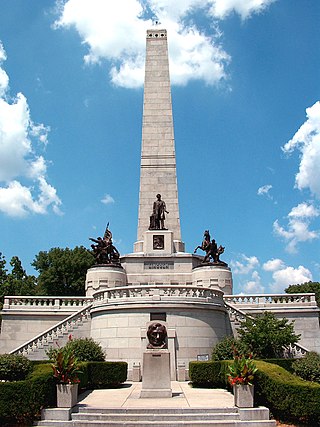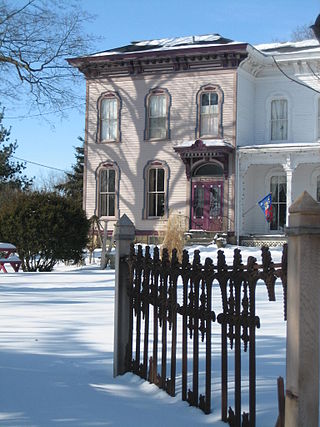
The Lincoln Tomb is the final resting place of Abraham Lincoln, the 16th president of the United States; his wife Mary Todd Lincoln; and three of their four sons: Edward, William, and Thomas. It is located in Oak Ridge Cemetery in Springfield, Illinois.

The Indiana State Soldiers and Sailors Monument is a 284 ft 6 in (86.72 m) tall neoclassical monument built on Monument Circle, a circular, brick-paved street that intersects Meridian and Market streets in the center of downtown Indianapolis, Indiana. In the years since its public dedication on May 15, 1902, the monument has become an iconic symbol of Indianapolis, the state capital of Indiana. It was added to the National Register of Historic Places on February 13, 1973, and was included in an expansion of the Indiana World War Memorial Plaza National Historic Landmark District in December 2016. It is located in the Washington Street-Monument Circle Historic District. It is also the largest outdoor memorial and the largest of its kind in Indiana.

The Peace Monument, also known as the Navy Monument, Naval Monument or Navy-Peace Monument, stands on the western edge of the United States Capitol Complex in Washington, D.C. It is in the middle of Peace Circle, where First Street and Pennsylvania Avenue NW intersect. The surrounding area is Union Square, which the monument shares with the Ulysses S. Grant Memorial, James A. Garfield Monument, and the Capitol Reflecting Pool. The front of the monument faces west towards the National Mall while the east side faces the United States Capitol.

The Ellwood House was built as a private home by barbed wire entrepreneur Isaac Ellwood in 1879. It is located on First Street in DeKalb, Illinois, United States, in DeKalb County. The Victorian style home, designed by George O. Garnsey, underwent remodeling in 1898-1899 and 1911. The house was originally part of 1,000 acres (4.0 km2) which included a large stable complex known as "Ellwood Green." Isaac Ellwood lived here until 1910 when he passed the estate to his son, Perry Ellwood.

The Sycamore Historic District is a meandering area encompassing 99 acres (400,000 m2) of the land in and around the downtown of the DeKalb County, Illinois county seat, Sycamore. The area includes historic buildings and a number of historical and Victorian homes. Some significant structures are among those located within the Historic District including the DeKalb County Courthouse and the Sycamore Public Library. The district has been listed on the National Register of Historic Places since May 2, 1978.

The DeKalb County Courthouse is located in the county seat of DeKalb County, Illinois, U.S., the city of Sycamore. The Classical Revival structure sits on a square facing Illinois Route 64 as it passes through the city. The current courthouse was constructed in 1905 amid controversy over where the courthouse and thus, ultimately, the county seat would be located. The current building is the third structure to bear the name "DeKalb County Courthouse." DeKalb County's Courthouse still serves as the county's primary judicial center and is a contributing property to the Sycamore Historic District. The district joined the National Register of Historic Places in 1978. As the county's primary courthouse for over 100 years, the site has been host to many trials, including prominent murder cases.

The Ogle County Courthouse is a National Register of Historic Places listing in the Ogle County, Illinois, county seat of Oregon. The building stands on a public square in the city's downtown commercial district. The current structure was completed in 1891 and was preceded by two other buildings, one of which was destroyed by a group of outlaws. Following the destruction of the courthouse, the county was without a judicial building for a period during the 1840s. The Ogle County Courthouse was designed by Chicago architect George O. Garnsey in the Romanesque Revival style of architecture. The ridged roof is dominated by its wooden cupola which stands out at a distance.

The Soldier's Monument in Byron, Illinois, is a listing on the National Register of Historic Places. Located in Ogle County, Illinois, the monument is the city of Byron's only National Register listing. This monument is the oldest still standing in Illinois, despite being struck by lightning and damaged by a tornado in 1918.

The Soldiers' Monument is a memorial consisting of three statues, one in bronze and two in marble by sculptor Lorado Taft, grouped around an exedra designed by the architectural firm of Pond and Pond. It is located in Oregon, Illinois, the county seat of Ogle County, Illinois. It was dedicated in 1916. The sculpture is part of the Oregon Commercial Historic District. The district was designated and listed on the National Register of Historic Places in August 2006.

The Chauncey Ellwood House is a 19th-century Italianate residence in the DeKalb County, Illinois city of Sycamore. It is a contributing property to the Sycamore Historic District; added to the National Register of Historic Places in 1978. The house is in the 800 block of Somonauk Street. The Esther Mae Nesbitt House, next door, was once the carriage house for the home.

The Carlos Lattin House was built by Sycamore, Illinois' first permanent settler, Carlos Lattin. It lies within the boundaries of the Sycamore Historic District and is listed as one of the contributing structures in the district. The Sycamore Historic District was added to the National Register of Historic Places in 1978.

Francis Derwent Wood was a British sculptor.

The Grand Army of the Republic Memorial Hall, also known as the Greenhut Memorial, was constructed as a memorial to American Civil War soldiers in Peoria, Illinois, United States in 1909. It was designed by Hewitt & Emerson. The Classical Revival hall was dedicated to Joseph B. Greenhut, Captain of Company K, 82nd Illinois Volunteer Infantry Regiment. The building was added to the National Register of Historic Places on July 13, 1976, and was listed as an example of Beaux-Arts architecture. It is also listed as a City of Peoria Local Historic Landmark in March 1996.

The houses in the Sycamore Historic District, in Sycamore, Illinois, United States, cross a variety of architectural styles and span from the 1830s to the early 20th century. There are 187 contributing properties within the historic district, 75% of the districts buildings. Many of the homes are associated with early Sycamore residents, usually prominent business leaders or politicians. Houses within the district are known by, either their street address or by a name associated with a prominent owner or builder. For most of the houses, the latter is true.

As of 2007 there are five church buildings in the Sycamore Historic District, located in Sycamore, Illinois, United States which are listed as contributing properties to the district. The Sycamore Historic District was added to the U.S. National Register of Historic Places on May 2, 1978. When it was nominated to join the National Register there were seven church buildings within the district. One of those included is a residential structure that was utilized as a church when it was first constructed; the Arthur Stark House was once home to the Sycamore Universalist Church congregation. In the time since its listing, two churches have been destroyed or demolished. The Evangelical Lutheran Church of St. John was destroyed by fire in 2004 and the United Methodist Church in Sycamore is no longer extant, replaced by a modern office building.

The commercial buildings in the Sycamore Historic District, located in Sycamore, Illinois, United States, are mostly located in and around the city's downtown. The largest concentration of commercial contributing properties to the historic district are found along Illinois Route 64 as it passes through Sycamore. They include several buildings known as "blocks" which can consist of more than one adjacent and attached structure, as is the case with the Waterman Block, one of the Sycamore commercial buildings.

The Dupont Circle Fountain, formally known as the Rear Admiral Samuel Francis Dupont Memorial Fountain, is a fountain located in the center of Dupont Circle in Washington, D.C. It honors Rear Admiral Samuel Francis Du Pont, a prominent American naval officer and member of the Du Pont family. The fountain replaced a statue of Du Pont that was installed in 1884. Designed by Henry Bacon and sculpted by Daniel Chester French, the fountain was dedicated in 1921. Prominent guests at the dedication ceremony included First Lady Florence Harding, Secretary of War John W. Weeks and Secretary of the Navy Edwin Denby.

The Soldiers' Monument is an American Civil War memorial located at the northern corner of Galena Avenue and Stephenson Street in Freeport, Illinois. General Smith D. Atkins designed the monument, which was erected in 1871. The limestone obelisk monument is 83 feet (25 m) tall; a statue of Victory originally topped the monument, but it was destroyed by a lightning strike in 1960. Marble tablets at the base of the memorial listed the names of Stephenson County's Civil War casualties; these were reversed and covered by bronze plaques in 1924 to allow space to list all of the county's Civil War veterans. Four 7-foot (2.1 m) statues were located at the corners of the base, which were replaced by identical replicas in 1924. The statues represent soldiers from each major branch of the Union military: the Infantry, Cavalry, Artillery, and Navy.

Sedgwick County Memorial Hall and Soldiers and Sailors Monument (1911–13) is a Civil War monument on the grounds of the Old Sedgwick County Courthouse, in Wichita, Kansas. It was designed by E. M. Viquesney, with sculpture by Frederick Hibbard and the W. H. Mullins Manufacturing Company. The idea to construct a memorial to Sedgwick County Civil War veterans began with two local GAR posts in 1904, but sufficient funds were not available until in 1911. In that year the Kansas State Legislature passed a one-time county tax levy to fund the building of monuments in counties with a population of over 72,000.





















